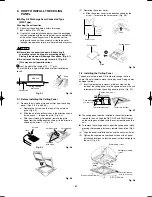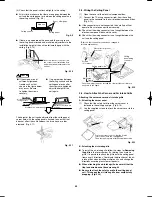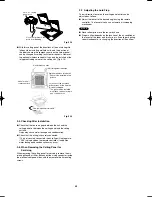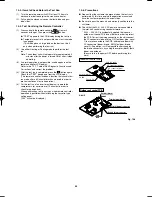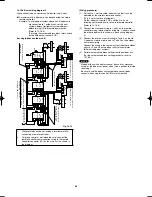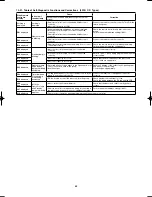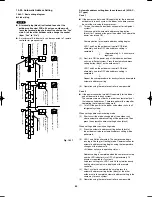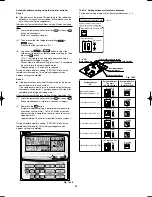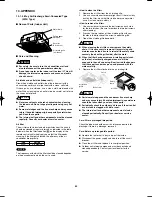
54
10-16. System Control
System control refers to the link wiring connection for control of
simultaneous-operation multi systems, group control, and main-
sub remote controller control.
10-16-1. Basic wiring diagram 1
Single type and simultaneous-operation multi system
●
Simultaneous-operation multi system
Up to 4 (Double-Twin) indoor units can be connected to 1
outdoor unit for operation.
(However, coordinate the outdoor unit capacity and the total
capacity of the indoor units.)
(It is not possible to connect individual remote controllers for
independent operation.)
●
Be careful to avoid miswiring when connecting the wires.
(Miswiring will damage the units.)
(for Single-phase outdoor unit)
L
N
L
N
1
2
1
2
1
2
2 1
1
2
0
L
N
L
N
2 1 N L
LN
1
2
(Using a wired remote controller with a
single-type system)
1.
Wall-mounted units do not include a
terminal plate for connecting a remote
controller.
2.
To connect the remote controller, a
remote controller cord is required.
Remote controller communication wiring
(Dia. 0.5 to 2 mm
2
)
Total length of wiring 200 m or less
Example:
Using a wireless remote controller with a
simultaneous-operation multi
system
System address (S2)
(Setting at shipment: “0”)
Leakage breaker
Leakage breaker
Leakage breaker
Leakage breaker
Outdoor unit
Inter-unit control wiring
Wall-
mounted
type
Indoor
unit
No. 1
2P
(white)
Connection to lead wire
(White / Black)
Wireless remote
controller
For group control (wiring locally supplied)
Wall-
mounted
type
Indoor
unit
No. 2
Wall-
mounted
type
Indoor
unit
No. 3
Out-
door
unit
Indoor
unit
4P
terminal
plate
Wired remote
controller
(Field
supply)
white
black
Ground
Ground
Ground
Ground
Ground
Ground
* When using wall-mounted units in a simultaneous-operation multi
system, connect the remote controller communication wiring to the
remote controller connector (2P) on the main unit, as shown in the
diagram.
Fig. 10-11
(Wiring procedure)
(1) Set the No. 1 wall-mounted indoor unit so that it can be
operated by the wireless remote controller. (This is set at
the time of shipment.)
On the indoor unit control PCBs, set the No. 2 and
following wall-mounted units to the sub remote controller.
(Refer to 10-16-5.)
(2) Connect the crossover wiring to the lead wires (white/black)
that extend out from the remote controller connectors of the
No. 1 indoor unit and other wall-mounted indoor units (as
shown in Basic wiring diagram 1).
Connect the crossover wiring to 1 and 2 on the remote
controller wiring terminal plate for units (4-way, ceiling-
mounted, etc.) other than the No. 1 indoor unit.
(3) Connect the inter-unit control wiring to 1 and 2 on the No.
1 indoor unit terminal plate, and to 1 and 2 on the outdoor
unit terminal plate.
Also connect the inter-unit control wiring between the
indoor units.
(4) When the indoor and outdoor unit power is turned ON,
automatic address setting is performed (when there is only
1 outdoor unit or when the system address is “0”).
NOTE
* If the system address is “0”, automatic address setting is
performed when the power is turned ON (in the case shown in
Basic wiring diagram 1).
This requires approximately 4 – 5 minutes (when the outdoor /
indoor unit ratio is 1:1 as shown in Basic wiring diagram 1).
During automatic address setting, LED 1 and 2 on the outdoor
unit control PCB blink alternately. These LED turn OFF when
automatic address setting is completed.
Airwell̲PAC-i̲eng.indb 54
Airwell̲PAC-i̲eng.indb 54
2009/07/09 16:13:39
2009/07/09 16:13:39
Summary of Contents for OU-PSINV-25HR
Page 75: ...75 ...


